- Flights
- Parking & Transport
- Airport guide
-
Shop, Dine & Stay
Shop, Dine & Stay
- Discover
- 中文
- Search
Language
Language





Sydney Airport warmly welcomes thousands of passengers every day through our domestic and international terminals. We are committed to providing an inclusive and accessible experience for all passengers and visitors.
The staff that work at Sydney Airport, including volunteer Airport Ambassadors are dynamic, caring, helpful, proactive and approachable and work as a team to ensure your experience is one of ease as your travel through Sydney Airport.
Sydney Airport consists of three terminals:
Airlines offer differing levels of service and ‘special assistance’ to passengers. Check with your airline before you book your flight, to check that their inclusion and accessibility policies, procedures and services meet your needs.
Travel agents can be very helpful with this process. Your chosen airline or travel agent can also give advice on:
You can also find more information about preparing for travel, passports and visas here.
Wearing a sunflower lanyard at Sydney Airport enables staff to recognise that you have a hidden disability. If you would like to identify your hidden disability, you can pick up a hidden disabilities lanyard at one of the following locations:
At security screening and passport control this lets staff know that you may need more time and support through processes. Where possible, staff will facilitate you through the special assistance lanes. Note this lanyard does not give you fast track access through security or passport control.
If you haven't done so already, be sure to contact your airline and make them aware of any special assistance requirements that you may have before you travel.
The airport environment can be intense and overwhelming due to the sensory demands (for example, things you see, hear, touch, smell and feel) and because of the processes, such as check-in and security, that we are required to participate in.
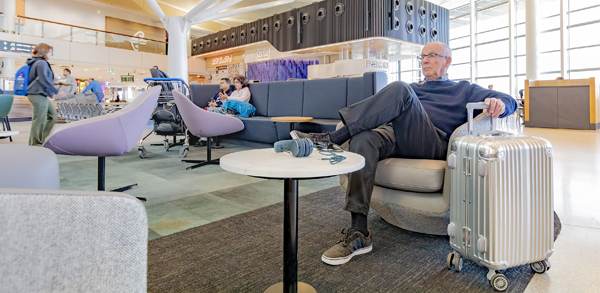
Sensory friendly travel tips
Some things that can support your participation at Sydney Airport are:
It is acceptable to pack a reasonable amount of essential items for your flight in your carry-on baggage, such as medicines and/or hypodermic needles. All other medicines and medical aids need to be packed in your checked baggage.
Medical aids such as oxygen tanks and wheelchairs can all be catered for. Please check with your airline.
Assistance animals are welcome inside our terminal. Information regarding the eligibility and travel requirements is available on the Department of Agriculture website.

The standard timeframe needed for airlines and service providers such as travel agents to arrange specific assistance is 48 hours. This means it is now time to:
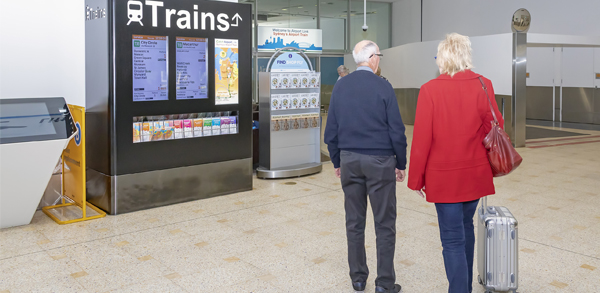
For more information on transport options, visit our Transport options page.
Sydney Airport provides accessible parking for people with mobility parking permits within the Domestic and International car parks. There are a total of 60 disability accessible parking bays across the three on precinct Domestic car parks. At the International precinct, there are three separate designated parking areas, with a total of 56 disabled bays available. You will find these spaces clearly signed.
More information on accessible parking options can be found on our parking page.
Our maps showing parking and walking distances you need to travel, will help you navigate your way through this part of your journey.
Please note this is a service from kerb to check-in only. Accessibility bookings must be made directly with your airline when booking your travel ticket. Check with your airline before you book your flight to understand if their inclusion and accessibility policies, procedures and services meet your needs.
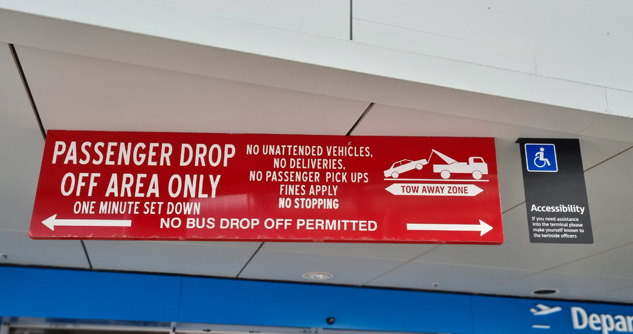 Above: Accessible drop off signage at T1 Departures
Above: Accessible drop off signage at T1 Departures
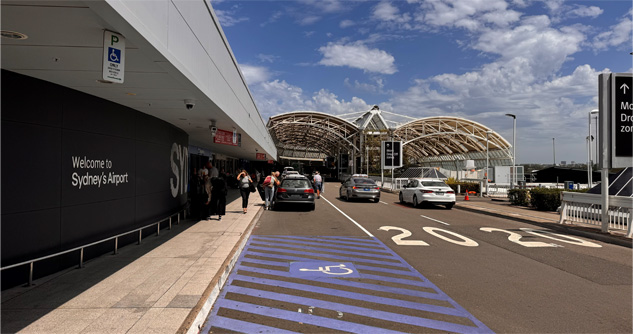 Above: Blue accessibility parking zones
Above: Blue accessibility parking zones
Taxi, rideshare, hire car and limousine drivers with unaccompanied passengers should stop in one of the accessible drop off zones at the kerbside outside the terminals.
Drivers can leave their vehicle to enter the terminal and alert a staff member from the relevant airline that there is a passenger in their vehicle requiring mobility assistance from the kerbside to the airport terminal, or alternatively notify a member of Sydney Airport’s kerbside management team who will alert a staff member from the relevant airline.
Passengers should remain in the vehicle during this time to ensure that vehicles in proximity to the terminal are not left unattended for security reasons.
Check-in locations
Check-in counters are located on Level 2, Departures in all of our terminals.
Types of Check-In Available
Depending on your airline, there may be different options which may include mobile check-in, online check-in, check-in kiosks, auto check-in and airport check-in. Thinking ahead and planning the way you check-in for your flight, may also determine the assistance you can access.
Check-In Deadlines
Confirming deadline for check-in with your airline is important. Carriers are not able to delay flights and being late may result in the loss of your fare.
Luggage
Be aware of the luggage size, weight and content requirements as each airline’s requirements will differ. In general, each passenger is responsible for lifting their luggage onto the weigh belt at check-in. If travelling by yourself and you need assistance with your luggage, pre-arrange support by contacting your airline. Your travel agent can also assist you with this.
Documentation
Domestic: You will need to present your ticket, identification such as a drivers license or proof of age card, and boarding pass if you have already have one from a check-in kiosk.
International: You will need to present your passport and ticket.
Flight Information Displays (FIDS)
The terminals have many Flight Information Display Screens (FIDS) throughout the public areas to advise flight arrival and departure times, boarding calls, ‘flight landed’ information, gate numbers and baggage carousel details.
In keeping with Sydney Airport’s quiet terminal initiative, in T1, passenger and flight announcements will be contained to gate areas. Any essential announcements will be made across the terminal.
You can also check the status of your flight through the Sydney Airport website.
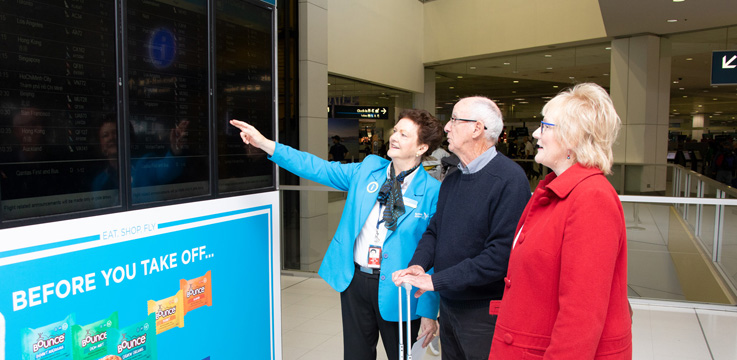
Location of Security
Security is on the same level as Check-In. If it is not immediately visible to you, ask staff at the check-in counter or one of our volunteer Airport Ambassadors to direct you.
Clearing Security with ease
The key to clearing security with ease is to be prepared and remain calm. Remember security is a service that ensures your safety. You can help the flow of the security process by
Getting to know the security process
Always leave ample time to make your way through security, particularly if you have implants, pacemakers, walk aids and or other prosthesis.
During the security process, you will be asked to take part in a security screening (i.e., X-ray, Body Scanner and Metal Detector) or a physical search (or pat down) and/ an Explosive Trace Detection (ETD).
X-ray

Body Scanner and Metal Detectors
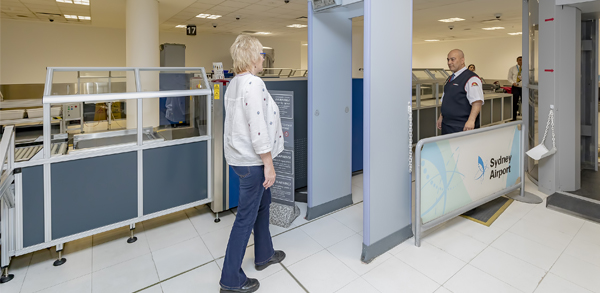
Physical Search or pat down
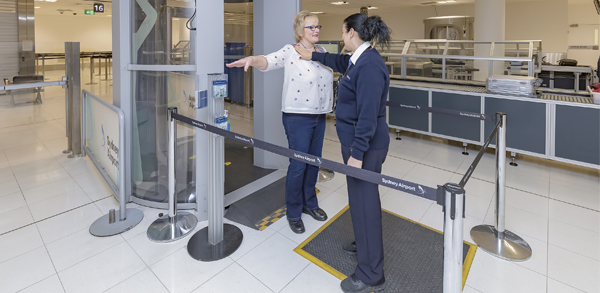
Explosive Trace Detectors (ETD)
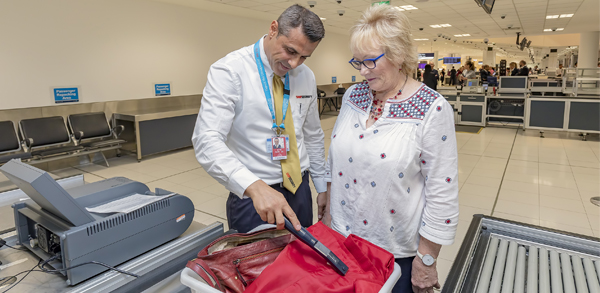
You will find more detailed information on security at Sydney Airport here.
If you’re departing from T1 International terminal, you will be required to go through passport control either electronically via SmartGate or manually with an Australian Border Force (ABF) Officer.
Families travelling with young children, passengers who are unable to use Smartgate without assistance and those with non-scannable passports will be directed to an Australian Border Force Officer for manual processing.
How to use SmartGates
If using the departures SmartGates does not work for you, you will be checked by an Australian Border Force officer.
Throughout the airport, you will find many retail shops, including duty free shopping and varied food and beverage outlet. You will also find facilities such as accessible bathrooms, pharmacies, ATMS, drinking fountains, charging station, printers, public telephones and TTY phones. A full list of accessible services and facilities can be found here.
Free Wi-Fi is available throughout our terminals.
If you are walking to your gate, orientate yourself by looking out for signage. To assist with wayfinding through the terminal you can use:
You can view or download our terminal maps here.
If you require immediate medical assistance, please present yourself to any airport employee or volunteer ambassador and request Sydney Airport First Aid.
Accessing your plane
An aircraft is accessed usually via ramps and aerobridge. If you need wheelchair assistance, please pre-arrange with the airline 48 hours prior.
Boarding your plane
Boarding will be managed by your airline. General timings are listed as below.
| Terminal | Arrive to gate |
|---|---|
| T1 International | 60 minutes prior |
| T2 Domestic | 30 minutes prior |
| T3 Domestic | 30 minutes prior |

If you are a blind or low visibility traveller, you can use a free service to help you navigate your way through Sydney Airport’s International and Domestic terminals. Please visit the Aira website to find out more.
Most aircraft will usually disembark via an aerobridge, however some flights may require passengers to exit via stairs to the tarmac.
If you have advised your airline of your additional assistance requirements, assistance will be ready and available to you.
If you are arriving on an international flight you will need to participate in passport control processes. Please make sure you have your passport, visa (if applicable) and completed incoming passenger card which you would have received on board the aircraft.
You will be required to go through passport control either electronically via SmartGate or manually with an Australian Border Force (ABF) Officer.
Families travelling with young children, passengers who are unable to use Smartgate without assistance and those with non-scannable passports will be directed to an Australian Border Force Officer for manual processing.
Quarantine and Biosecurity
To help protect Australia’s environment, Australian Department of Agriculture and Water Resources and Australian Border Force Officers screen all incoming international passengers and their belongings.
It is mandatory to declare certain items on your Incoming Passenger Card. Your bags may be checked as part of this process.
If you have any specific enquiries regarding these procedures including additional information on assistance animals please contact the Department of Home Affairs or the Department of Agriculture and Water Resources.
You will now collect your luggage from the baggage reclaim area. If you require assistance removing your luggage from the carousel, please make direct contact with your airline.

Delayed baggage
If you’re unable to locate your bag on arrival from the baggage reclaim, you will need to approach airline staff at the airport to complete a report to describe your bag in detail, along with your contact information and delivery address. You can follow up with your airline’s ground handler here.
Transfer flights
Your airline will be able to advise if you need to collect your luggage, before transferring for your next flight.
If you are transferring from the International terminal to Domestic terminal, all passengers must collect their luggage and pass through passport control and Quarantine requirements before transferring to the Domestic Terminal.
The following options are available if you are transferring between T1 International and T2/T3 Domestic terminals. Should you require assistance, please contact your airline to see what assistance they are able to offer.
If you are transferring on a Qantas or Virgin Australia flight, you may be eligible to use an airline transfer service. For more information and to confirm your eligibility please click here.
Train
Airport Link offers a $7.00 (one way, per person) single transfer ticket for passengers travelling between the T1 International and T2/T3 Domestic terminals via train. However, pricing does vary if the traveller is using an Opal Card.
The journey takes only two minutes and there are frequent services between 5am and midnight, seven days a week.

Taxi
Kerbside staff can assist you with organising specific requirements you have for transport (i.e., wheelchair accessible taxis).
A taxi journey between T1 International and the T2/T3 Domestic terminals will take up to 10 minutes, depending on the time of day
The approximate cost for this journey is $18.00 - $23.00 (one way, per taxi)

There are many ground transport options available for all passengers departing from all of our terminals including: car, bus, train, shuttle, taxi, ride share operators such as Uber and UberAssist, rental cars, limousines, self drive and, bikes.
More information can be found here.
Two accessible pick up spaces are available on the Arrivals level of all terminals with wheelchair ramps. Drivers must remain with their vehicle at all times.

Pick up when no Mobility Parking Permit is displayed
If you are picking up a passenger with a disability, and as a driver you do not have a Mobility Parking Permit, the driver may utilise the disabled zones. However, the passenger with the disability must be waiting at the kerbside.
For a full list of accessible facilities throughout our terminals, visit our accessible facilities and services page.
This map identifies high sensory and low sensory areas to help you navigate through the terminal. This can help you prepare for additional noise, crowded areas and identify areas where you can stop in a quieter area if required.
View or download the sensory map here.
A visual social story is a picture based explanation of what to expect and what you’re expected to do when visiting the airport. It can help you to understand what is going to happen, and prepare for your journey.
Download and print our helpful Journey Planner before you travel. Refer to the planner throughout your journey for tips, reminders and useful contact information.
If you require additional medical assistance* before, during or after your flight, Medical Travel Companions offer a comprehensive assistance service for passengers travelling through Sydney Airport.
Visit the Medical Travel Companions website for more information.
*Please note, airlines have complimentary support services as part of your airline ticket. We recommend confirming the level of service offered by your airline prior to booking.